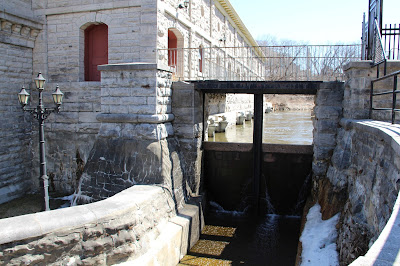In Ottawa in a small park on the northwest corner of Somerset Street West and Spadina Avenue stands a plaque commemorating the village of Hintonburg.
HINTONBURG
1893—1993
Originally part of Nepean Township and named after Joseph Hinton, Hintonburg was incorporated as a village in December 1983, and annexed to the City of Ottawa in December 1907.
Erected by the Hintonburg Community Association.
Unveiled 11 December 1993.
Faisant partie originellement du canton de Nepean et nommé en l'honneur de Joseph Hinton, Hintonburg fut constitué en village en décembre 1893 et annexé à la ville d'Ottawa en décembre 1907.
Don de l'Association communautaire de Hintonburg.
Inauguration de 11 décembre 1993.

Thursday, May 31, 2018
Monday, May 28, 2018
Van Camp WWI Cenotaph
In Mountain Township, Ontario, the Van Camp World War One Cenotaph stands in front of an old church on the north side of Levere Road, east of Development Road.
 |
| 1914-1918 |
Thursday, May 24, 2018
Timber Rafting on the Ottawa Plaque
In Arnprior, Ontario, to get to the plaque commemorating timber rafting on the Ottawa River go to the conjunction of Riverview Drive and McLean Avenue, go west on narrow and unpaved Leo Lavoie Road and keep to the right to almost the end, then make your way from there to the furthest point west where the Madawaska River flows into the Ottawa River. There stands the plaque.
TIMBER RAFTING ON THE OTTAWA
The rafting of square timber down the Ottawa River, begun in 1806, reached its peak during 1861-91 and ended in 1909. Pine "sticks" from one to two feet square and 40 to 50 feet long were floated down tributary rivers such as the Petawawa, Madawaska, Bonnechere and Mississippi to rafting points on the Ottawa. There "cribs" were made up, containing 20 to 40 pieces of timber, and as many as 200 cribs were taken in turn assembled into a raft. These rafts could be taken apart for passage down rapids or the timber slides which by-passed them. Arriving at Quebec City as much as two months later, they were dismantled and the timber loaded for shipment overseas.
Archaeological and Historic Sites Board of Ontario
TIMBER RAFTING ON THE OTTAWA
The rafting of square timber down the Ottawa River, begun in 1806, reached its peak during 1861-91 and ended in 1909. Pine "sticks" from one to two feet square and 40 to 50 feet long were floated down tributary rivers such as the Petawawa, Madawaska, Bonnechere and Mississippi to rafting points on the Ottawa. There "cribs" were made up, containing 20 to 40 pieces of timber, and as many as 200 cribs were taken in turn assembled into a raft. These rafts could be taken apart for passage down rapids or the timber slides which by-passed them. Arriving at Quebec City as much as two months later, they were dismantled and the timber loaded for shipment overseas.
Archaeological and Historic Sites Board of Ontario
Monday, May 21, 2018
Fleet Street Pumping Station
In Ottawa, the Fleet Street pumping station occupies a location south east of the east end of Fleet Street in LeBreton Flats.
NATIONAL HISTORIC CIVIL ENGINEERING SITE
FLEET STREET PUMPING STATION
Originally constructed to provide a safe water supply for public use and for fire fighting purposes, this pumping station remains a lasting tribute to the prominent civil engineers responsible for its design and construction. Due to their innovative use of water power to drive the pumping equipment and superb engineering skills, the Fleet Street pumping station continues to be a key component of the City of Ottawa's water supply system.
1874-75 CONSTRUCTION ENGINEER THOMAS C. KEEFER
1888 EXPANSION CITY ENGINEER ROBERT SURTEES
1901 EXPANSION CITY ENGINEER NEWTON KER
CANADIAN SOCIETY FOR CIVIL ENGINEERING 2011
SITE HISTORIQUE NATIONAL DU GÉNIE CIVIL
POSTE DE POMPAGE DE LA RUE FLEET
Construit initialement pour assurer l'alimentaion en eau potable et lutter contre les incendies, ce poste de pompage demeure un hommage aux éminents ingénieurs civils qui en ont assuré la conception et la construction. Le poste utilise de façon novatrice la force hydraulique pour actionner les équipements de pompage. Le poste de pompage de la rue Fleet est demeuré un élément essentiel du système d'approvisionnement en eau de la ville d'Ottawa.
THOMAS C. KEEFER INGÉNIEUR CONSTRUIT EN 1874-75
ROBERT SURTEES INGÉNIEUR MUNICIPAL EXPANSION EN 1888
NEWTON KER INGÉNIEUR MUNICIPAL EXPANSION EN 1901
2011 LA SOCIÉTÉ CANADIENNE DE GÉNIE CIVIL
 |
| WATER WORKS ENLARGED 1888 COMMITTEE ALDERMAN J C. ROGER, CHAIRMAN. ALD. G. DALGLISH. ALD. G. COX. ALD. J. O'LEARY. ALD. S. BINGHAM. ALD. E. G. LAVERDURE. ROBERT SURTEES, ENGINEER W. J. LOUGHRAN, CONTRACTOR |
NATIONAL HISTORIC CIVIL ENGINEERING SITE
FLEET STREET PUMPING STATION
Originally constructed to provide a safe water supply for public use and for fire fighting purposes, this pumping station remains a lasting tribute to the prominent civil engineers responsible for its design and construction. Due to their innovative use of water power to drive the pumping equipment and superb engineering skills, the Fleet Street pumping station continues to be a key component of the City of Ottawa's water supply system.
1874-75 CONSTRUCTION ENGINEER THOMAS C. KEEFER
1888 EXPANSION CITY ENGINEER ROBERT SURTEES
1901 EXPANSION CITY ENGINEER NEWTON KER
CANADIAN SOCIETY FOR CIVIL ENGINEERING 2011
SITE HISTORIQUE NATIONAL DU GÉNIE CIVIL
POSTE DE POMPAGE DE LA RUE FLEET
Construit initialement pour assurer l'alimentaion en eau potable et lutter contre les incendies, ce poste de pompage demeure un hommage aux éminents ingénieurs civils qui en ont assuré la conception et la construction. Le poste utilise de façon novatrice la force hydraulique pour actionner les équipements de pompage. Le poste de pompage de la rue Fleet est demeuré un élément essentiel du système d'approvisionnement en eau de la ville d'Ottawa.
THOMAS C. KEEFER INGÉNIEUR CONSTRUIT EN 1874-75
ROBERT SURTEES INGÉNIEUR MUNICIPAL EXPANSION EN 1888
NEWTON KER INGÉNIEUR MUNICIPAL EXPANSION EN 1901
2011 LA SOCIÉTÉ CANADIENNE DE GÉNIE CIVIL
Subscribe to:
Comments (Atom)

















































